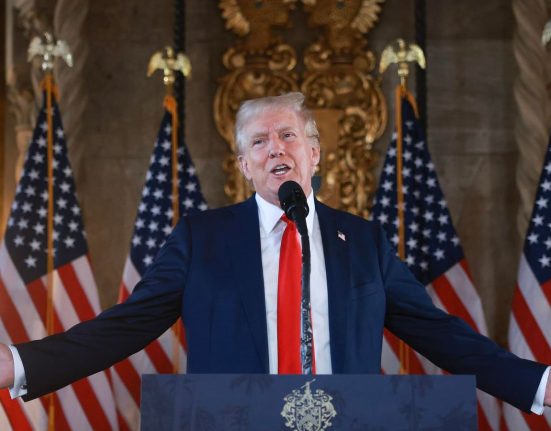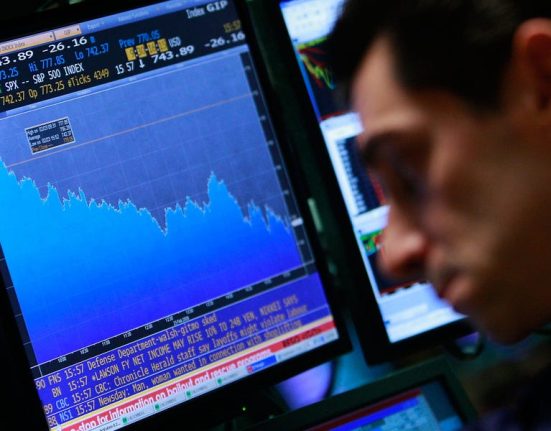
People on Wall Street react to sinking stocks from tariffs
People on Wall Street reacted to the stock market downturn from Trump’s tariffs announcement with a mix of worry and optimism.
- President Donald Trump defended his tariff strategy in light of the stock market’s quick fallout, saying “sometimes you have to take medicine to fix something.”
- One stock market analyst stated Monday: “Retaliation smells stronger than negotiation, right now.”
The wildfire on Wall Street burned into 401(k) retirement savings accounts across the country with such intensity that it cannot be ignored. Or written off as something that’s only bashing the elites.
What’s less evident right now — yet clearly significant — is that the checkbooks of consumers nationwide will suffer in the months ahead, too, as the tariff story unfolds.
After two back-to-back brutal days, the Dow Jones Industrial Average once again plunged in trading on Monday. Shortly after the 9:30 a.m. opening bell on Wall Street, the Dow was down 1,158.25 points or 3.02%. The Dow was trading down roughly 3.15% by shortly before 10 a.m. to trade around 37,107.66 points.
The Standard & Poor’s 500 index was down 3.38% in early trading minutes after the opening bell. But down 1.86% shortly after 10 a.m.
It will once again be a highly volatile day.
Auto stocks got slammed again, fluctuating by the minute in price.
Before 10 a.m., Stellantis was down roughly 7%. By 10:12 a.m., though, Stellantis gained ground and was down 2.26% to trade at $9.50 a share.
Ford Motor was down 4.5% in early trading and by 10:12 a.m., Ford was down 1.46% to trade at $9.44 a share.
General Motors stock was trading down about 3.9% and by around 10:13 a.m., GM stock was down 0.25% to trade at $44.07 a share.
Worries on Wall Street have been packaged by some Trump loyalists as the grumbling of the well-to-do. But Trump’s massive re-writing of decades of trade policy is going to hit working class people hard when it comes to their ability to spend, save, and have a shot at steady employment, according to predictions from experts.
The wealthy may complain, but they have far more resources to absorb the blow. Lower-income and middle-class families have much less room for error and experiments.
If you were investing to save for a new house, the financial fallout means you lost a great deal of that potential down payment.
On Sunday, President Donald Trump once again defended his tariff strategy. Speaking to reporters aboard Air Force One late Sunday, he said jobs would return to the United States to make it “wealthy like never before,” according to news reports.
“Sometimes you have to take medicine to fix something,” Trump said of the stock shock.
Where the stock market meltdown ranks
The Dow closed at 38,314.86 points on Friday — losing 3,910.46 points or 9.26% in just two days of trading since Trump’s Rose Garden announcement of across-the-board tariffs, including what some American and Vietnamese business leaders call a “shockingly high” 46% tariff on Vietnam. Vietnam is eager to negotiate, urging Trump to delay the April 9 implementation date for the tariffs.
The Dow fell more than 6,500 points — or 14.6% — from its close on Jan. 30 through Friday.
The Dow’s record close was set on Dec. 4 when the blue-chip index hit 45,014.04 points. And the Dow was down nearly 14.9% from that record high through Friday’s close.
The broader-based Standard & Poor’s 500 index lost nearly $5.06 trillion in value in the fiery sell-off, or 10.53% in two days of trading. The index is down by more than 17% since the Feb. 19 peak when the index closed at 6,144.15 points.
The two-day stock shock ranks as No. 14 when it comes to percentage losses over two days for the S&P 500 index. The worst two-day losing streak for the S&P 500 index remains at a 24.57% for the Oct. 18 and Oct. 19, 1987. Based on market value lost, though, the April 3 and April 4 stock plunge was the worst, according to data from Sam Stovall, chief investment strategist for CFRA Research.
The panic during the early days of the COVID-19 pandemic in 2020 triggered a 13.93% two-day decline for the S&P 500, ranking as the sixth worst two-day decline in history in percentage terms, Stovall said.
Swissquote Bank senior analyst Ipek Ozkardeskaya said last week’s downturn “marked the beginning of a historical market sell-off.”
He noted that tariff “retaliation smells stronger than negotiation, right now.”
Friday’s sell-off ignited further after China said that the country would retaliate against Trump’s trade fight with 34% tariffs on U.S. imports.
How higher tariffs will hurt everyday households
The sudden smack into 401(k) and individual stock prices has been dreadful. But the turmoil over the Trump tariff tsunami promises to pack a wallop to wallets across America, hitting those who don’t own any stocks, too.
Trump’s long list of tariffs, as they stood on Friday, are estimated to equate to a $1,900 tax hike in 2025 on average for U.S. households, according to estimates by the Tax Foundation, a nonpartisan group that conducts research on tax policy.
How much individual households will actually see their real incomes, or after-tax incomes, fall will vary based on their spending patterns and what tradeoffs a consumer is willing to make.
In some cases, for example, someone might save some money by buying domestic-made goods to avoid the higher costs of tariffs. But, experts say, some U.S. manufacturers can be expected to raise their prices too as they’re dealing with an uncertain trade environment.
The consumer cost would have been far higher, perhaps in the $2,100 range based on earlier estimates, but news of roughly 40 exemptions to some high tariffs was released late Thursday, said Garrett Watson, director of policy analysis at the Tax Foundation.
Lower-income and middle-income households will feel the biggest squeeze on their finances, analysts say, given that many have tended to shop within their budgets by selecting lower-priced items that are imported here. As imports are hit by higher tariffs, prices can be expected to rise.
Bottom line, we’re talking about reducing the amount of cash that consumers can spend on anything else — just like the impact of a traditional tax hike.
The imposed tariffs will reduce after-tax incomes 1.9 % on average, according to the Tax Foundation’s analysis, with the top 1% of taxpayers seeing a smaller 1.6% reduction in after-tax incomes.
Tariffs raise revenue for the U.S. government, Watson said, but reduce the after-tax income for Americans.
“People who are most impacted are working class folks; middle class folks; lower, middle-income Americans,” Watson said.
They’re spending a higher portion of their income on food, clothing and other necessities and goods. Lower-income to middle-income families are more likely to need to shop for bargains that are often associated with imported items made in other countries that pay workers lower wages.
Shopping options might drop
The Tax Foundation isn’t looking at estimating the specific price hikes or inflation ahead.
How high prices could go up will depend on the strength of the economy, whether we see a recession and how the other countries respond to tariffs. When other countries retaliate by imposing their own tariffs, U.S. companies that export their goods oversees are more likely to see declining sales.
In the months ahead, Watson said, consumers will have fewer options to buy lower prices goods that are imported. They could be left with little choice but to buy more expensive alternatives that they didn’t pick up in the past.
“People are going to be poorer and people are going to be able to buy less real stuff after the tariffs are imposed,” Watson told the Detroit Free Press.
Some individuals will decide to save less — or even borrow more — if their wages don’t go up to deal with price hikes.
“Of course, it comes at a time when these tariffs are going to slow the economy,” Watson said. “Jobs may be more unstable. If they can save less at the same time, that’s sort of a double whammy.”
Trump imposed various tariffs in his first term, but the tariffs were limited then and many consumers didn’t see across-the-board hits to their portfolios or pockets. The latest moves — which the White House dubs as a way to “level the playing field for American workers and businesses” — are far broader.
So far, many consumers aren’t seeing immediate changes in prices due to tariffs. The stock market’s slump reflects how traders anticipate corporate profits will fall due to tariffs in the future.
Consumers are extremely sensitive to price hikes now, though, after they watched inflation peak nearly three years ago. One of Trump’s campaign promises included bringing grocery prices down, too.
Effects on higher priced items
If you’re buying a new car in the next year or so, you could face an even more damage to your wallet.
The East Lansing-based Anderson Economic Group released a wide range of potential tariff-related costs for some cars, SUVs and trucks.
The extra tariff-related cost is estimated to range from $2,500 to $4,000 for some small crossovers, sedans and one midsize SUV assembled in the United States, according to the report. The report by the Anderson Economic Group, forecast a $5,000 to $8,500 jump in costs due to tariffs when it comes to many midsize vehicles and some pickup trucks.
“Prices for most vehicles will start going up after the inventory is exhausted,” Anderson said Monday morning. “That could be two months or so for many models, but quite soon for those in high demand. Used car prices are already up.”
Many people who have been steadily saving in their 401(k) plans, 529 college savings plans and elsewhere feel numb. One friend told me she felt like throwing up after she went online and saw the shocking amount of 401(k) money she had lost in just a few days.
More people than one might imagine have money riding on stocks. A record 58% of U.S. households owned stock directly or through retirement savings accounts, such as 401(k) plans, in 2022, according to the latest Survey of Consumer Finances issued by the Federal Reserve. That’s up from 53% in the Fed’s 2019 survey.
Wealthier families, of course, tend to have far more money riding on the line when the stock market implodes. But many also have better jobs and more access to advice on how to ride out the storm.
The Fed report noted there are significant differences in the value of stock market holdings across income groups. Yet anyone who saw a 10% drop or more in the value of their 401(k) is bound to be nervous, no matter how much money they have invested.
Time for more deep breaths. Many savers still have money in their 401(k) plans, particularly if they’ve been saving for quite some time. Many remain diversified, not investing every dollar in stocks. Not being glib, but you did not plan to spend every dollar next week shopping on Temu.
Some advisers are even bringing up the notion of a buying opportunity. When exactly you’d want to buy, of course, is debatable.
Swissquote Bank market analyst Ozkardeskaya said Monday morning in his note before trading began in New York that he believed “we will be seeing incredible buying opportunities in a few weeks. Keep calm and don’t forget that markets always bounce back.”
Robert Bilkie, CEO of Sigma Investment Counselors in Northville, sent a note to clients this weekend indicating that hopes remain for more negotiations, which could shore up stocks. The firm manages about $2 billion for 750 clients.
“We think that the markets have misinterpreted the Trump tariffs as final,” according to the note to clients.
“Instead of tariff wars, we’re likely to have a reconciliation and a general reduction in global tariff rates (as Israel, Vietnam, and Great Britain have all initiated reductions). Trump’s tariffs are expected to be substantially less as countries come to the negotiating table bringing reduced tariffs of their own,” the alert suggested.
Melissa Joy, president of Pearl Planning, a wealth adviser in Dexter, told the Detroit Free Press she’s had several clients who are looking to put money into the stock market right now.
“I’ve encouraged them to put something in now, but not everything they’ve set aside,” Joy said.
“We’re approaching bear market territory for some assets, such as small caps and the Nasdaq — never a horrible time to buy if you’re a long-term investor, but there could be more trouble ahead.”
What if you’re too nervous to buy stocks right now? Or worried about losing your job, if there’s a recession ahead? Or if you’re retired and thinking that you don’t see a 25-year runway left if it takes that long for your stock portfolio recover?
“Use this time to spring clean and if you’re nervous, try to put away a little extra cash,” Joy said.
“The same goes for retirees. You may choose to modify some of your spending plans if we have a prolonged recession, but for now, you’re likely able to continue as planned,” she said.
We don’t know, of course, what will happen next. And that uncertainty is bound to create more rocky moments.
Most of us need to spend some time trying to refocus on the long haul, as the country works its way out of all the economic turmoil being triggered by Trump’s tariff tantrum.
Contact personal finance columnist Susan Tompor: stompor@freepress.com. Follow her on X @tompor.






